Comprehensive Guide to SOC 2 Audit Process, Preparation and Best Practices in 2025

SOC 2 audits, short for Service Organization Control 2 audits, are a critical component of ensuring the security and reliability of service organizations in today's digital world. These audits are designed to evaluate and report on the controls in place at a service organization that are relevant to the security, availability, processing integrity, confidentiality, and privacy of customer data. SOC 2 audits are conducted by independent auditors and result in a detailed report that provides valuable insights into an organization's data protection practices.
The significance of SOC 2 audits cannot be overstated. In an era where data breaches and cybersecurity threats are on the rise, customers, and partners are increasingly concerned about the safety of their data when working with service providers.
SOC 2 audits provide a level of assurance and transparency regarding an organization's data handling practices. They demonstrate a commitment to safeguarding sensitive information and maintaining the highest standards of data security.
In this blog, we will explore the intricacies of SOC 2 audits, including the criteria used for evaluation, the SOC 2 audit process itself, and the benefits that organizations can derive from undergoing these assessments.
What is SOC 2 audit?
SOC 2 audits are conducted by independent third-party auditors who assess whether the organization's controls and processes align with the Trust Services Criteria. The goal is to provide assurance to customers and stakeholders that the service provider has effective controls in place to protect data.
Why does SOC 2 Audit matter?

SOC 2 compliance is not only about protecting sensitive data but also about gaining trust and credibility in a competitive business environment. It demonstrates an organization's commitment to data security and provides reassurance to customers and stakeholders, ultimately contributing to the organization's long-term success. Let's see how:
1. Protecting sensitive data
SOC 2 compliance is paramount for organizations that handle sensitive customer data, and here's why it matters:
- Data security: SOC 2 focuses on controls related to data security, among other areas. Compliance ensures that an organization has robust measures in place to protect sensitive information from unauthorized access, breaches, or theft.
- Legal and regulatory obligations: Many industries are subject to specific data protection regulations, such as GDPR, HIPAA, or CCPA. SOC 2 compliance helps organizations meet these legal and regulatory obligations by demonstrating their commitment to safeguarding customer data.
- Risk mitigation: Data breaches can have severe financial and reputational consequences. SOC 2 compliance helps mitigate these risks by reducing the likelihood of data breaches and the associated legal liabilities and fines.
2. Gaining trust and credibility
SOC 2 compliance goes beyond just protecting data; it also plays a crucial role in building trust and credibility with customers, partners, and stakeholders:
- Customer expectations: In today's data-driven world, customers expect the organizations they work with to have robust data protection practices in place. SOC 2 compliance assures customers that their data is in safe hands, fostering trust.
- Competitive advantage: Being SOC 2 compliant can give an organization a competitive edge. It sets them apart from competitors who may not have undergone the rigorous audit process. Potential clients are more likely to choose a service provider with proven security controls.
- Third-party assurance: SOC 2 compliance provides an independent assessment of an organization's controls by a qualified auditor. This external validation adds credibility to the organization's claims about its data protection measures.
- Reduced due diligence: When organizations can present a SOC 2 report, it can streamline the due diligence process for potential clients or partners. They can review the report to understand the controls in place, reducing the need for extensive audits and questionnaires.
- Supplier relationships: Many larger organizations require their suppliers and vendors to be SOC 2 compliant as part of their risk management strategy. Achieving compliance can open doors to partnerships and contracts with these organizations.
Common challenges in SOC 2 audit and how to overcome them
ChallengeDescriptionSolutionLack of awareness and understanding
Many organizations may lack awareness of SOC 2 and may not fully understand its significance or requirements.Education and training: Invest in training programs to educate key personnel about SOC 2, its objectives, and its relevance to your organization.
Engage experts: Seek guidance from experienced consultants or auditors who can explain the requirements in a clear and understandable manner.
Internal communications: Foster open communication channels to ensure that all employees understand the importance of SOC 2 compliance and their roles in achieving it.Resource constraintsResource limitations, including budget and staffing, can hinder an organization's ability to prepare for and undergo a SOC 2 audit.Prioritization: Prioritize compliance efforts based on risk and criticality. Focus resources on the most critical controls and systems first.
Efficiency tools: Utilize technology and automation to streamline compliance tasks and reduce the burden on staff.
Outsourcing: Consider outsourcing specific compliance tasks or engaging third-party experts to conduct assessments, which can be cost-effective.Evolving regulatory landscapeThe regulatory landscape is constantly changing, with new laws and regulations impacting data security and privacy.Continuous monitoring: Establish a robust monitoring system to stay informed about regulatory updates. Subscribe to industry newsletters and government notifications.
Legal counsel: Engage legal counsel with expertise in data protection and compliance to provide ongoing advice and guidance.
Scalable framework: Develop a compliance framework that is flexible and scalable, allowing you to adapt to new regulations as they emerge.
To refer to our article on seven ways to accelerate your SOC 2 compliance process, click here.
Industries that benefit from SOC 2 audit and compliance
SOC 2 compliance benefits a wide range of industries and organizations that handle sensitive customer data or rely on secure and reliable services. Here are examples of industries and their specific use cases for SOC 2 compliance:
SectorUse caseExamplesTechnology and SaaS companies:Technology companies, especially those offering Software as a Service (SaaS), benefit significantly from SOC 2 compliance. They can assure customers that their data will be handled securely and reliably.Cloud service providers, online collaboration platforms, data analytics services.Healthcare and healthcare ITThe healthcare industry has stringent regulations like HIPAA. SOC 2 compliance helps healthcare providers and health IT companies demonstrate their commitment to protecting patients' sensitive health information.Hospitals, electronic health record (EHR) vendors, and telemedicine platforms.Financial servicesFinancial institutions handle vast amounts of financial data, making them a prime target for cyberattacks. SOC 2 compliance helps build trust with clients and regulators by demonstrating strong security controls.Banks, credit unions, payment processors, fintech companies.Data centers and hosting providersData centers and hosting providers store and manage critical data for organizations. SOC 2 compliance ensures the security and availability of these services.Data centers, web hosting companies, cloud infrastructure providers.Legal and professional servicesLaw firms and professional services companies handle sensitive client information, including legal documents. SOC 2 compliance demonstrates their commitment to confidentiality and data protection.Law firms, accounting firms, consulting firms.E-commerce and retailE-commerce companies collect and process customer payment information and personal data. SOC 2 compliance assures customers that their financial and personal details are secure.Online retailers, e-commerce platforms.
Education and edtechEducational institutions and technology providers in the education sector handle student and academic data. SOC 2 compliance is crucial for maintaining data privacy and security.Schools, universities, online learning platforms.Manufacturing and supply chainManufacturing companies often collaborate with suppliers and partners. SOC 2 compliance ensures the security of supply chain data and intellectual property.Manufacturers, suppliers, logistics companies.Media and entertainmentMedia companies collect user data for personalized content and advertising. SOC 2 compliance helps them protect user privacy and meet legal requirements.Streaming platforms, media networks, advertising agencies.Government and public sectorGovernment agencies and public sector organizations handle citizens' sensitive information. SOC 2 compliance is essential to maintain trust and comply with data protection regulations.Government agencies, municipal services, public utilities.
Steps to Prepare for a SOC 2 audit
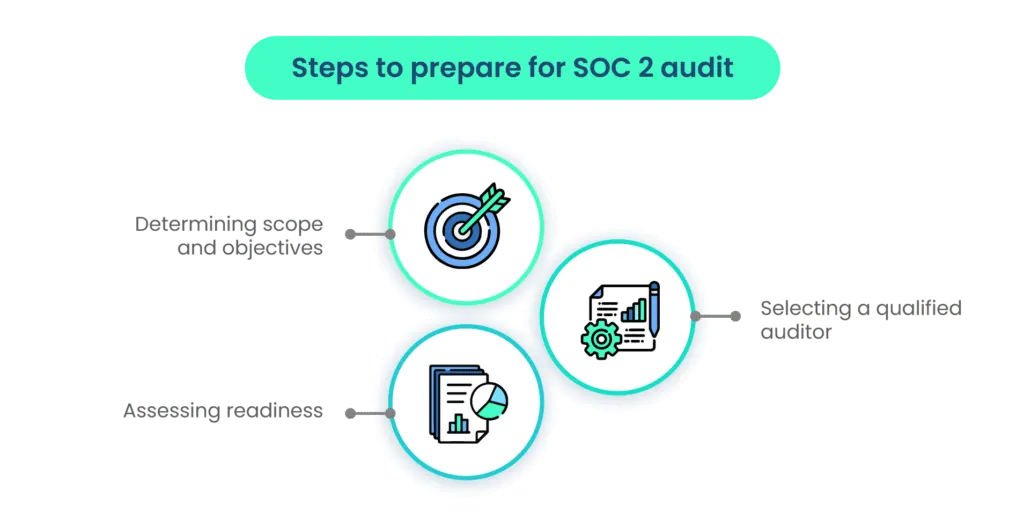
Preparing for a SOC 2 audit is a meticulous process that involves careful planning and assessment of an organization's controls and practices. Here's a breakdown of the key steps involved:
A. Determining scope and objectives:
- Scope definition: Define the scope of your SOC 2 audit. Determine which systems, processes, and services will be included in the audit. Ensure that you clearly understand which Trust Services Criteria (e.g., security, availability, confidentiality) are relevant to your organization.
- Objective setting: Clearly define the objectives you want to achieve through the SOC 2 audit. For example, you may aim to demonstrate data security to gain customer trust or meet regulatory requirements.
B. Selecting a qualified auditor:
1. Qualifications and credentials to look for:
- CPA designation: Ensure that the auditor holds a Certified Public Accountant (CPA) designation, as this is typically required for SOC 2 audits.
- Experience: Look for auditors or audit firms with experience in conducting SOC 2 audits for organizations in your industry or with similar service offerings.
- Reputation: Research the reputation of potential auditors or audit firms. Seek referrals and read client reviews or testimonials.
- Industry knowledge: An auditor with industry-specific knowledge can better understand the unique challenges and risks in your sector.
2. Interviewing potential auditors:
- Ask about experience: In the interview, inquire about their experience with SOC 2 audits, especially in your industry. Ask for references from previous clients.
- Audit approach: Understand their audit methodology, including how they plan to assess controls, conduct testing, and provide recommendations.
- Timeline and costs: Discuss the estimated timeline for the audit and the associated costs. Ensure transparency in pricing.
- Communication: Assess their communication style and responsiveness. Effective communication throughout the audit process is crucial.
C. Assessing readiness:
1. Identifying gaps and weaknesses:
- Current controls: Conduct a thorough assessment of your organization's existing controls and practices. Identify areas where you may have gaps or weaknesses.
- Risk assessment: Prioritize identified gaps based on their potential impact on security, availability, confidentiality, and other relevant criteria.
- Documentation review: Review your existing documentation, policies, and procedures to ensure they align with the Trust Services Criteria.
- Testing internal controls: Perform internal control testing to validate the effectiveness of your controls. This can help identify areas that may need improvement.
2. Developing a remediation plan:
- Prioritize remediation: Based on the identified gaps and weaknesses, create a remediation plan that outlines specific actions, responsible parties, and timelines for addressing each issue.
- Policy and procedure updates: Revise and update policies and procedures to align with the Trust Services Criteria and industry best practices.
- Training and awareness: Implement training and awareness programs to ensure that employees understand and follow the updated controls and procedures.
- Testing and validation: Test and validate remediated controls to ensure they are effective and meet the SOC 2 requirements.
- Continuous monitoring: Establish ongoing monitoring processes to maintain and improve control effectiveness over time.
In conclusion, preparing for a SOC 2 audit requires careful planning, including defining scope and objectives, selecting a qualified auditor, assessing readiness, and developing a comprehensive remediation plan. This thorough preparation is essential to ensure a successful SOC 2 audit and the demonstration of robust data security and privacy controls.
The SOC 2 audit process

The following are the steps for carrying out the SOC 2 audit process:
A. Planning and scoping
The first step in the SOC 2 audit process is planning and scoping.
1. Defining the audit scope
- Clearly define the scope of the SOC 2 audit, including the systems, processes, and services to be assessed. Ensure alignment with the Trust Services Criteria that are relevant to your organization.
- Identify the specific controls and control objectives that will be evaluated during the audit.
2. Establishing the audit timeline
- Work with the auditor to set a realistic timeline for the audit process. Consider factors such as the complexity of your organization, the scope of the audit, and the availability of key personnel.
- Define milestones and deadlines for each phase of the audit.
B. Risk assessment
After the first step of planning, the organization should carry out a risk assessment for the SOC 2 audit process.
1. Identifying key risks
- Conduct a thorough risk assessment to identify potential threats and vulnerabilities related to the Trust Services Criteria.
- Consider internal and external factors that could impact data security, availability, processing integrity, confidentiality, and privacy.
2. Documenting risk mitigation controls
- Document the controls and safeguards you have in place to mitigate the identified risks. These controls should align with the TSC and be designed to address specific threats and vulnerabilities.
- Include policies, procedures, technical safeguards, and physical security measures in your SOC 2 audit checklist.
C. Control testing
Control testing is the next step in the SOC 2 audit process.
1. Evaluating the design and effectiveness of controls
- Assess the design of controls to ensure they are suitably designed to achieve their objectives. This involves reviewing policies, procedures, and system configurations.
- Evaluate the operating effectiveness of controls to determine if they are consistently applied and achieve their intended results.
2. Sample selection and testing procedures
- Select a representative sample of control activities or transactions for testing. The sample should be sufficient to provide assurance about control effectiveness.
- Conduct testing procedures, which may include examining documents, observing processes, and reviewing system logs.
D. Gathering evidence
The forth step in the SOC 2 audit process is gathering evidence.
1. Documentation and data collection
- Gather and organize documentation that supports the existence and operation of controls. This may include policies, procedures, logs, and incident reports.
- Ensure that evidence is well-documented, traceable, and accessible for the auditor's review.
2. Interviewing employees
- Interview key personnel to gain insights into control operations and verify that employees are aware of and adhere to security protocols.
- Document the outcomes of these interviews to provide additional evidence of control effectiveness.
E. Reporting
Reporting is a crucial step in the SOC 2 audit process.
1. Preparing the SOC 2 report
- Collaborate with the auditor to draft the SOC 2 report, which will typically include an opinion letter from the auditor and a description of the organization's controls.
- The report should also detail any identified control deficiencies and their severity.
2. Types of information included
- The SOC 2 report typically includes an auditor's opinion on the fairness of management's description of controls and the suitability of the design and operating effectiveness of those controls.
- It may also include a description of the scope, the results of control testing, and any recommendations for improvement.
F. Remediation and follow-up
The last step in the SOC 2 audit process is remediation and follow-up.
1. Addressing identified issues
- Develop and implement remediation plans to address any control deficiencies or weaknesses identified during the audit.
- Ensure that corrective actions are taken promptly and document the resolution of issues.
2. Continuous improvement
- Use the insights gained from the audit to drive continuous improvement in your organization's control environment.
- Regularly review and update policies and procedures to adapt to changing threats and risks.
Best Practices for a successful SOC 2 audit
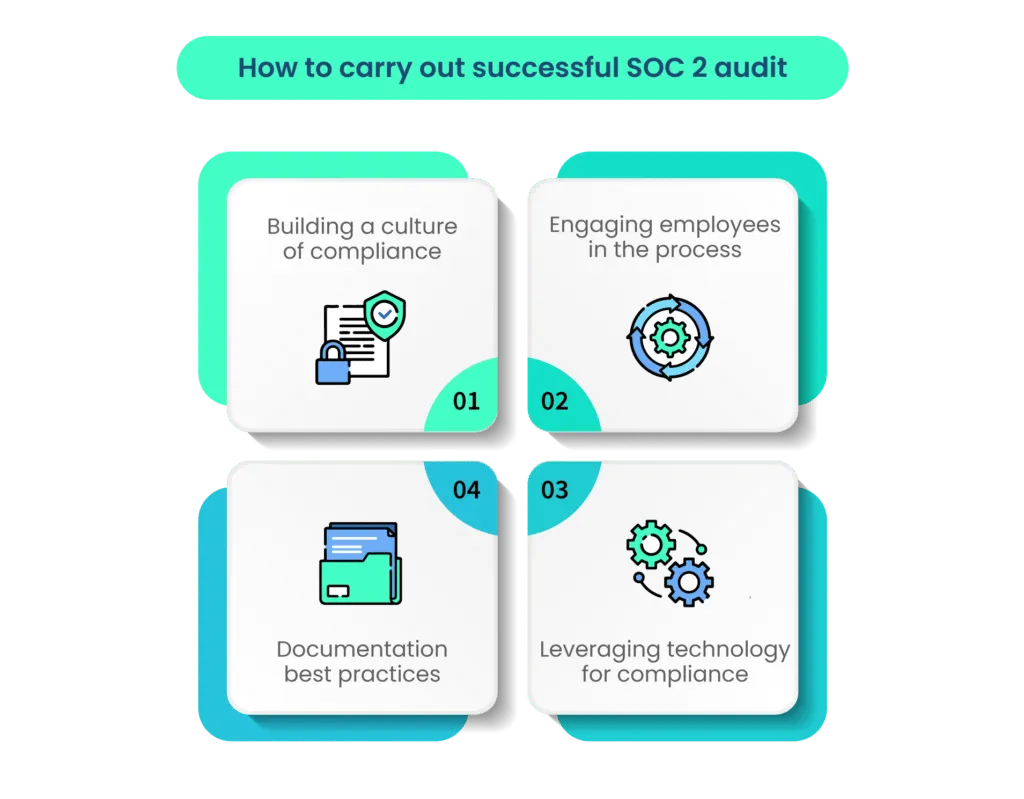
By following the tips given below, organizations can foster a culture of compliance, engage employees in the compliance process, maintain thorough documentation practices, and leverage technology to enhance their readiness for a successful SOC 2 audit. A proactive and collaborative approach to compliance not only ensures audit success but also strengthens an organization's overall security posture.
A. Building a culture of compliance
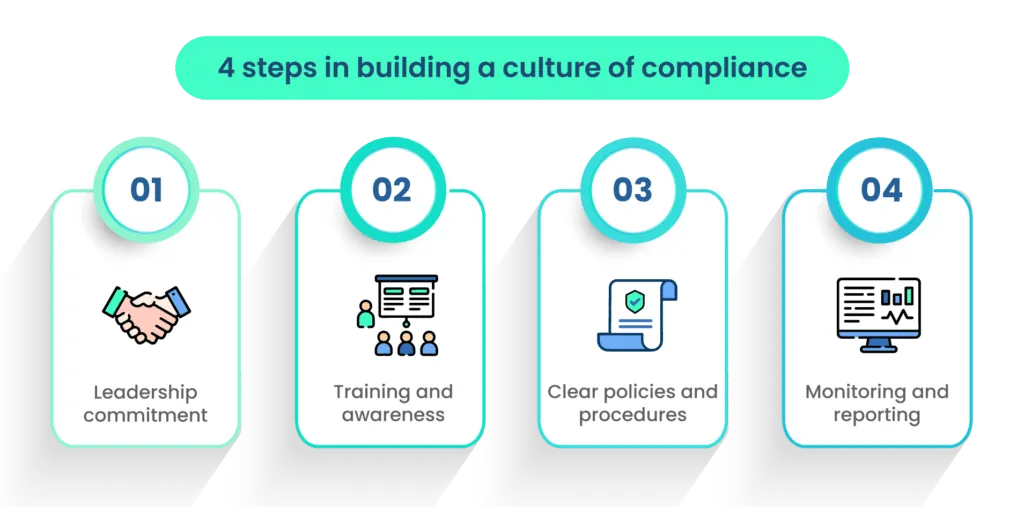
- Leadership commitment: Start at the top. Ensure that senior leadership is fully committed to compliance efforts and actively communicates the importance of SOC 2 compliance throughout the organization.
- Training and awareness: Provide regular training and awareness programs to educate employees about SOC 2 requirements and their role in compliance. Encourage a culture of security and accountability.
- Clear policies and procedures: Develop and maintain clear and comprehensive policies and procedures that align with the Trust Services Criteria. Ensure that employees understand and follow these guidelines.
- Monitoring and reporting: Implement continuous monitoring mechanisms to detect and address compliance issues proactively. Encourage employees to report any potential concerns or breaches promptly.
B. Engaging employees in the process
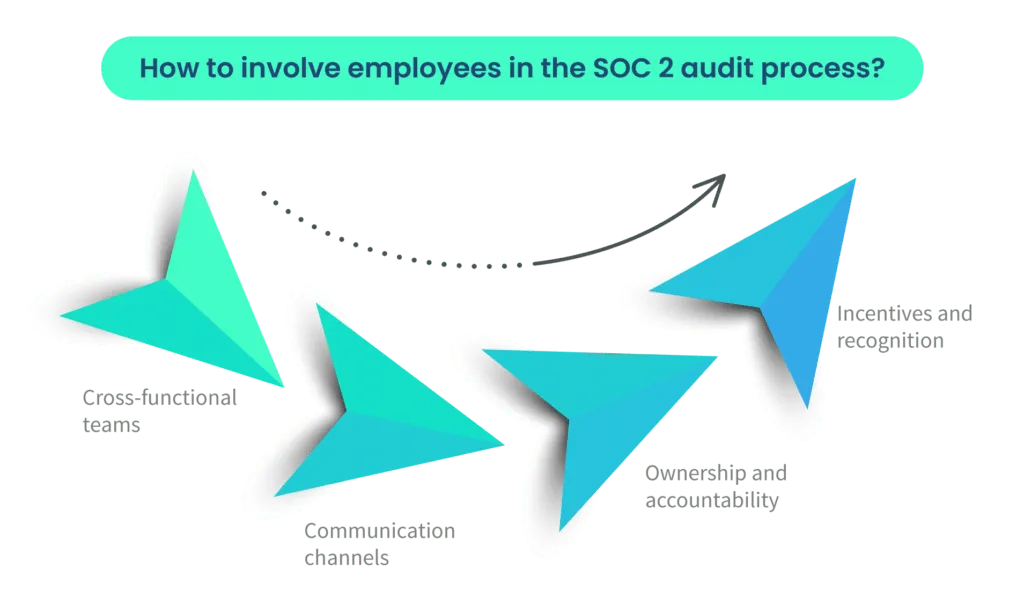
- Cross-functional teams: Form cross-functional teams that include representatives from IT, security, legal, and other relevant departments. This collaborative approach ensures a holistic view of compliance efforts.
- Communication channels: Establish open lines of communication where employees can ask questions, seek clarification, and report potential issues without fear of reprisal.
- Ownership and accountability: Assign ownership of specific compliance tasks and controls to responsible individuals or teams. Clearly define roles and responsibilities.
- Incentives and recognition: Recognize and reward employees who actively contribute to compliance efforts. This can foster a sense of ownership and pride in maintaining security controls.
C. Documentation best practices

- Version control: Maintain version control for policies, procedures, and documentation. Clearly label and date each revision to ensure that the most up-to-date information is used.
- Centralized repository: Create a centralized and easily accessible repository for compliance-related documents. This facilitates document retrieval and audit readiness.
- Record keeping: Keep detailed records of all compliance-related activities, including control testing, risk assessments, and employee training. These records serve as evidence during the audit.
- Regular review: Periodically review and update the documentation to reflect changes in regulations, technology, or business processes. Ensure that documentation remains accurate and relevant.
D. Leveraging technology for compliance
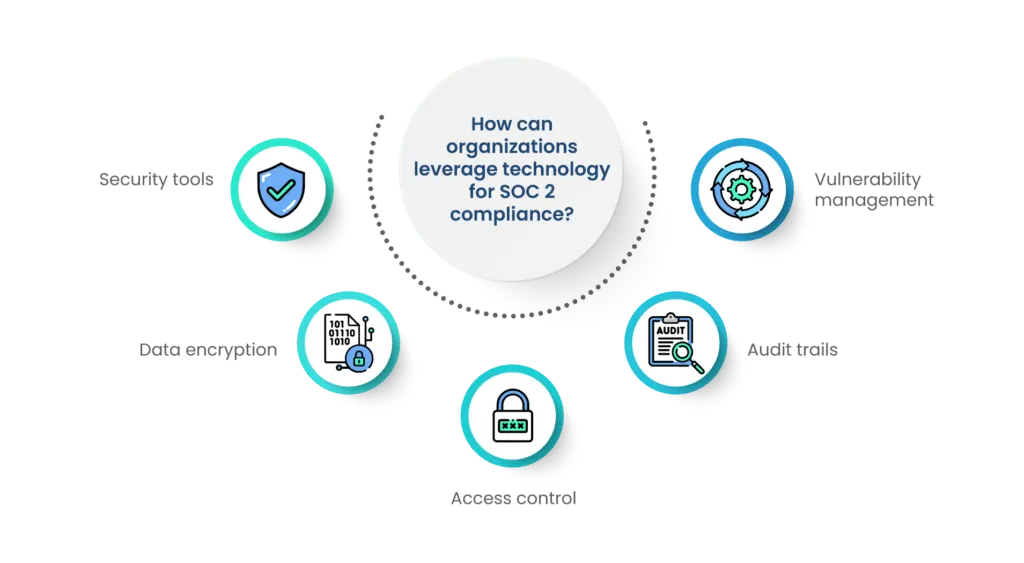
- Security tools: Implement security and compliance tools that help automate and streamline control monitoring and reporting. These tools can aid in continuous monitoring and alerting.
- Data encryption: Use encryption technologies to protect sensitive data at rest and in transit. Ensure that encryption protocols align with SOC 2 requirements.
- Access control: Implement robust access control mechanisms to restrict data access to authorized personnel only. Regularly review and update access privileges.
- Audit trails: Maintain comprehensive audit trails that log and monitor critical events and changes in your IT environment. These logs can be valuable for demonstrating control effectiveness.
- Vulnerability management: Utilize vulnerability scanning and patch management solutions to proactively identify and address security vulnerabilities.
Conclusion
In summary, SOC 2 audits are crucial for ensuring data security and reliability in today's digital age. They provide assurance to customers, partners, and stakeholders about an organization's commitment to safeguarding sensitive data.
SOC 2 compliance matters because it protects data, ensure legal adherence, mitigates risks, and builds trust and credibility. It benefits a wide range of industries, from technology and healthcare to finance and government.
Preparing for a SOC 2 audit involves careful planning, selecting auditors, assessing readiness, and creating remediation plans. A proactive approach to compliance, involving a culture of compliance, engaged employees, thorough documentation, and technology, is essential for success.
Ready to fortify your data security and gain trust through SOC 2 compliance? Connect with Scrut today and take the first step towards safeguarding your organization's sensitive data.
FAQs
1. What is SOC 2 compliance, and why is it important? SOC 2 compliance is a framework for evaluating and reporting on the controls and practices of service organizations related to data security, availability, processing integrity, confidentiality, and privacy. It's essential because it demonstrates an organization's commitment to protecting sensitive data, which is crucial in an era of increasing data breaches and cybersecurity threats.
2. Who needs SOC 2 compliance? Organizations that handle sensitive customer data or rely on secure and reliable services can benefit from SOC 2 compliance. This includes data centers, cloud service providers, SaaS companies, healthcare providers, financial institutions, and many others.
3. What are the key components of a SOC 2 audit report? A SOC 2 audit report typically includes an auditor's opinion on control design and effectiveness, a description of the scope, results of control testing, and any identified control deficiencies. It may also provide recommendations for improvement.


















